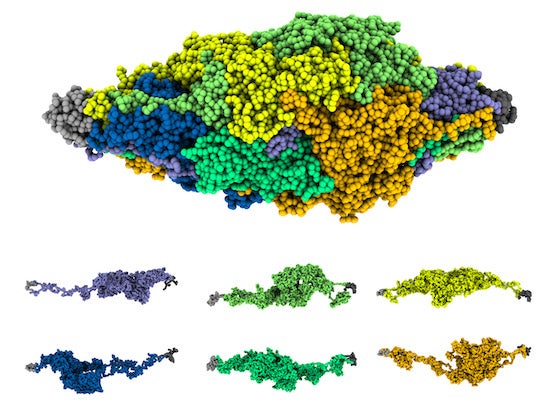When it comes to DNA, one pesky mosquito turns out to be a rebel among species.

Researchers at Rice University's Center for Theoretical Biological Physics (CTBP) are among the pioneers of a new approach to studying DNA. Instead of focusing on chromosomes as linear sequences of genetic code, they're looking for clues on how their folded 3D shapes might determine gene expression and regulation.
For most living things, their threadlike chromosomes fold to fit inside the nuclei of cells in one of two ways. But the chromosomes of the Aedes aegypti mosquito - which is responsible for the transmission of tropical diseases such as dengue, chikungunya, zika, mayaro and yellow fever - defy this dichotomy, taking researchers at the CTBP by surprise.
The Aedes aegypti's chromosomes organize as fluid-yet-oriented "liquid crystals," different from all other species, according to their study published in Nature Communications.
"Understanding DNA is a key to understanding how life works," said Rice theoretical physicist Peter Wolynes, a co-author on the study. "We are only just beginning to learn how the 3D architecture of chromosomes influences the functioning of genomes."
A 2021 collaborative study co-led by a team from the CTBP and published in Science reported that chromosomes display one of two structural patterns when cells are not dividing, the stage in the cell life cycle known as interphase.

"In a 'type two' genome architecture - like that found in humans and chickens, for instance - chromosomes form territories and don't mix together that much," said Vinícius Contessoto, a CTBP research scientist who is a lead co-author on the latest study and was also a co-author on the 2021 study.
The still-unknown forces that keep active and inactive parts of "type two" chromosomes separate from each other during interphase behave like those that prevent oil and water from mixing together.
"In a 'type one' architecture, like that found in yeast or in many plants, the regions of the chromosomes known as centromeres come together, folding them into an intermeshed, hairpin-like structure, polarized with telomeres " said José Onuchic, Rice's Harry C. and Olga K. Wiess Professor of Physics and Astronomy, and a professor of chemistry and biosciences.
"Something that's surprising to me is that even though so many different species have been mapped, they still largely fall into one of these two different classes," Wolynes said. "The Aedes aegypti mosquito is the first real outlier."

The genome of the Aedes aegypti is roughly half the length of the human genome and is organized into six large chromosomes, as opposed to humans' 46. "We used to think that the chromosomes of the mosquito did not form territories, but in fact they do form these elongated territories," Contessoto said.
"During interphase, 'type two' chromosomes are really very fluid, disordered things balled up into droplet-shaped territories," said Wolynes, Rice's Bullard-Welch Foundation Professor of Science and a professor of chemistry, of biochemistry and cell biology, of physics and astronomy, and of materials science and nanoengineering and co-director of the CTBP.
The chromosomes of the Aedes aegypti mosquito display fluid characteristics, separating from one another like liquid droplets of oil and water. At the same time, they are partially condensed by compaction forces, which gives them an unusual shape, oriented like an overlong football, suggesting their consistency is also similar to that of a crystal.
Moreover, if force is applied to a regular "type two" nucleus and it is deformed, the organization of the chromosomes inside remains unaffected. "It's like poking a water balloon - it reverts to its prior shape. But when we poke the nucleus of the mosquito cells, the chromosomes' patterns inside change dramatically," said Onuchic.
"This is an intriguing feature of 'type one' chromosome architecture that suggests there is a possible mechanism linking gene regulation to mechanical inputs on the cell," said Onuchic. In 2020, he and collaborators confirmed the existence of a mechanism connecting genome structure to gene expression.


Other co-authors of the new study are Erez Lieberman Aiden, a Rice adjunct assistant professor of computer science and an assistant professor of computational and applied mathematics, an associate professor of molecular and human genetics and a principal investigator in the joint Rice/Baylor College of Medicine Center for Genome Architecture; Olga Dudchenko, an assistant professor in the Center for Genome Architecture and former CTBP postdoctoral fellow; and Michele Di Pierro, an assistant professor of physics at Northeastern University. All are CTBP members.
The research was supported by the National Science Foundation (2019745, 2210291, 2019276, 2021795); the Welch Foundation (C-1792, Q-1866); the Cancer Prevention and Research Institute of Texas; the São Paulo State Research Foundation and Higher Education Personnel, and Higher Education Personnel Improvement Coordination (2016/13998-8, 2017/09662-7); the D.R. Bullard-Welch Chair at Rice (C-0016); the McNair Medical Institute Scholar Award; the National Institutes of Health (UM1HG009375, RM1HG011016-01A1, R35GM146852); and the AMD HPC Fund.






